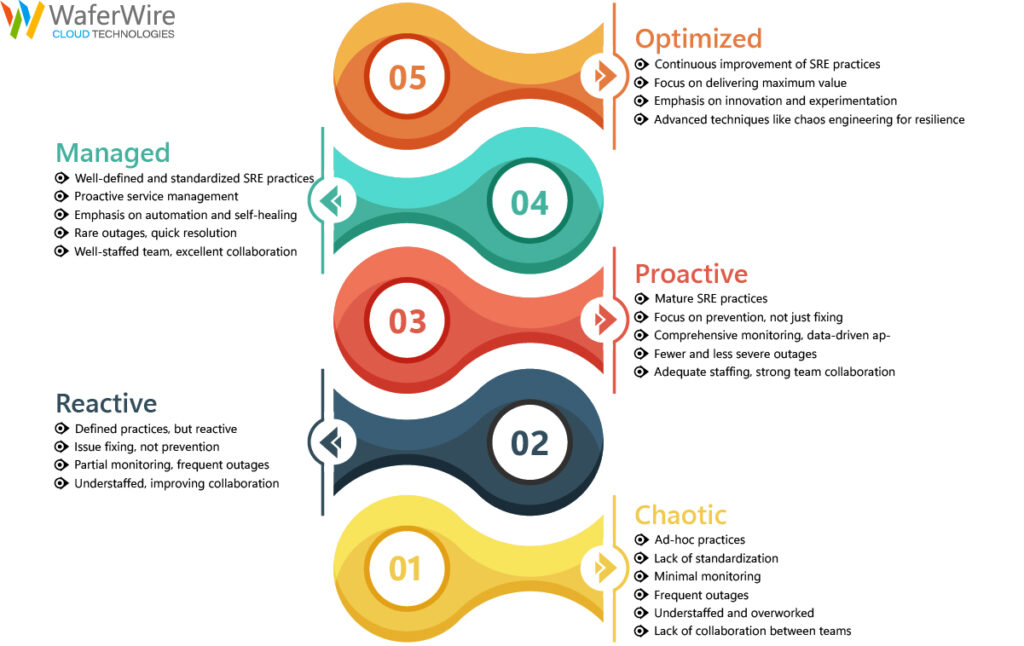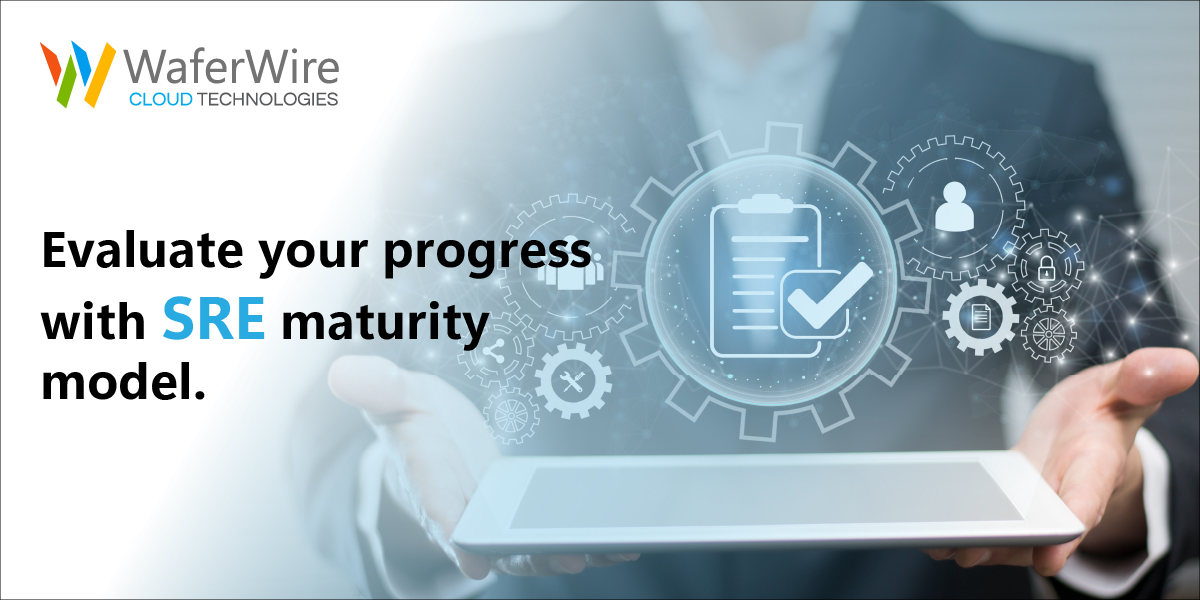Site Reliability Engineering (SRE) is a relatively new approach to managing IT infrastructure and applications. It has become increasingly popular recently as companies like yours strive to provide better performance, reliability, and availability for their digital services. The SRE Maturity Model is a framework that helps organizations assess their SRE maturity levels and identify areas for improvement. In this blog, we will explore the five maturity levels of the SRE Maturity Model and provide tips for conducting a successful self-assessment.
Introduction to the SRE Maturity Model
The SRE Maturity Model is a framework developed by Google to help organizations evaluate their SRE practices and identify areas for improvement. The model consists of five maturity levels, each representing a different stage in the evolution of SRE practices. The levels are:
- Chaotic
- Reactive
- Proactive
- Managed
- Optimizing
The SRE Maturity Model goal is to help organizations move from a chaotic, reactive approach to SRE to a proactive, optimized approach that delivers maximum value to the business.
Understanding the Five Maturity Levels

Chaotic
In the chaotic stage, SRE practices are ad-hoc and poorly defined. There is no standardization or consistency in how services are managed, and the focus is on putting out fires rather than preventing them. There is little or no monitoring, and outages are usual. The team is often understaffed and overworked. They have little or no collaboration between teams.
Reactive
In the reactive stage, SRE practices are more defined, but they are still reactive in nature. The team is focused on fixing issues as they arise rather than preventing them. There is some monitoring, but it is not comprehensive, and some frequent outages. The team is yet understaffed, but there is more collaboration between teams.
Proactive
In the proactive stage, SRE practices are more mature, and the team is focused on preventing issues before they occur. There is comprehensive monitoring, and the team uses data to identify and address potential issues. There are still some outages, but they are less frequent and less severe. The team is adequately staffed, and there is good collaboration between teams.
Managed
In the managed stage, SRE practices are well-defined and standardized. The team is focused on managing services proactively, and there is a strong emphasis on automation and self-healing. Outages are rare, and when they do occur, they are quickly resolved. The team is well-staffed, and there is excellent collaboration between teams.
Optimizing
In the optimizing stage, SRE practices continuously improve, and the team focuses on delivering maximum value to the business. There is a strong emphasis on innovation and experimentation, and the team uses advanced techniques like chaos engineering to test and improve the resilience of their services.
Conducting a Self-Assessment Using the SRE Maturity Model
To conduct a self-assessment using the SRE Maturity Model, review the five maturity levels and identify where your organization falls on the spectrum. This can be done by evaluating your SRE practices against the characteristics of each maturity level.
Once you have identified your current level of maturity, begin identifying strengths and weaknesses in your SRE practices. This can be done by evaluating each area of your SRE practices against the characteristics of the maturity level above and below your current level.
For example, if you are currently at the Reactive level, you can evaluate your SRE practices against the characteristics of the Chaotic and Proactive stages. This will help you identify areas; where you need to improve to move to the Proactive level.
Identifying Strengths and Weaknesses in Your SRE Practices
Once you have identified your current level of maturity and evaluated your SRE practices against the characteristics of the maturity levels above and below your current level, you can start identifying strengths and weaknesses in your SRE practices.
Start by identifying areas where your SRE practices are robust and meet the characteristics of the maturity level above your current level. These are areas where you are already doing well and can build on your strengths.
Next, identify areas where your SRE practices are weak and do not meet the characteristics of the maturity level below your current level. These are the areas to improve to move to the next level of maturity.
Creating an Action Plan for Improvement
Once you have identified your strengths and weaknesses, you can create an action plan for improvement. This plan should include specific, measurable, achievable, relevant, and time-bound (SMART) goals for each area of improvement.
For example, if you are currently at the Reactive level and need to move to the Proactive level, your action plan might include goals like:
- Implement comprehensive monitoring for all services
- Develop and test incident response procedures
- Automate usual tasks and processes
- Increase collaboration between teams
Tips for Using the SRE Maturity Model Effectively
To use the SRE Maturity Model effectively, keep the following tips in mind:
- Be honest about your current level of maturity
- Use the characteristics of each maturity level as a guide for improvement
- Focus on areas that will have a major impact on your organization
- Set SMART goals for each area of improvement
- Track your progress and adjust your plan as needed
Ready to level-up with SRE Maturity Model?
Common Challenges in Implementing the SRE Maturity Model
Implementing the SRE Maturity Model can be challenging for a variety of reasons. Some common challenges include:
- Lack of buy-in from stakeholders
- Lack of resources, including time, people, and budget
- Resistance to change
- Lack of understanding of SRE principles and practices
It is important to educate stakeholders on the benefits of SRE and the SRE Maturity Model to overcome these challenges. It is also vital to prioritize SRE initiatives and allocate resources accordingly. Finally, it is crucial to communicate the importance of SRE throughout the organization and build a culture of collaboration and continuous improvement.
Real-World Examples of Successful SRE Maturity Assessments
Many organizations have successfully used the SRE Maturity Model to assess their SRE practices and identify areas for improvement. For example:
- Spotify used the SRE Maturity Model to evaluate its SRE practices and identified areas for improvement, including incident management, monitoring, and automation.
- Target used the SRE Maturity Model to evaluate their SRE practices and identified areas for improvement, including incident response, reliability testing, and post-incident review.
- Google used the SRE Maturity Model to evaluate their SRE practices and identified areas for improvement, including service level objectives, disaster recovery, and SRE training.
Do you want to succeed in using the SRE maturity model?
Tools and Resources for SRE Maturity Assessments
There are several tools and resources available to help organizations conduct SRE maturity assessments, including:
- The SRE Workbook, a guide to implementing SRE practices
- The SRE Maturity Model Assessment Tool, a self-assessment tool developed by Google
- The SRE Learning Path, a collection of courses and resources for learning SRE principles and practices
In a nutshell,
The SRE Maturity Model is a framework for evaluating and improving SRE practices. By conducting a self-assessment using the model, organizations can identify strengths and weaknesses in their SRE practices and create an action plan for improvement. By following the tips and best practices outlined in this blog, organizations can overcome common challenges and successfully implement the SRE Maturity Model. Otherwise, you can approach an SRE service provider like us. The call is yours!
With the SRE Maturity Model as a guide, organizations can move from a novice to an expert approach that delivers maximum value to the business. So, how about discussing the SRE maturity model for your business? Give us a call at (+1) 206 792 9930 or write to us at info@waferwire.com.
